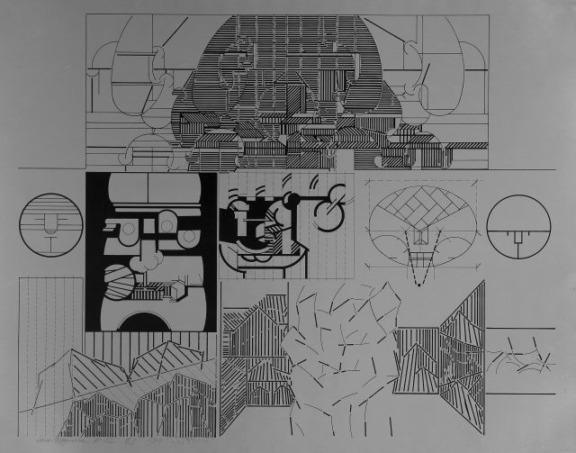
- 1984
- Off-set plate and K-line
- Inv. GP1934
Fernando Lemos
Série Memórias n.º 12
The eight prints from the ‘Memories Series’ were produced between 1983 and 1984 and form part of a larger group of 14 works that were shown in the exhibition Fernando Lemos. Drawings / Memories (Calouste Gulbenkian Foundation, 1985).
In the text that accompanied the exhibition, Lemos stated that he chose offset aluminium plate as the medium for drawing so as to avoid the fragility of paper, claiming that ‘[…] I’m anti-paper. Because I think it has an old-fashioned fragility […] the transference of the drawing, first executed on polyester paper, to aluminium plate permanently imprints its integrity on the material […].’ However, the truth is that this more rigid medium also allows for the reproduction of the drawing, that being precisely the usual function of an offset plate.
It should be noted that offset production is similar to photography in that it also involves light sensitizing the plate when the drawing (on translucent paper or transparent acetate) is placed in contact with the aluminium plate to later undergo a process of development. The sensitized plate constitutes a matrix of the drawing, like the photographic negative is the matrix of an image, allowing its reproduction.
In this series of ‘drawings / memories,’ it is interesting to note the convergence of a process of creation of drawings based on technical processes of reproduction that, in their genesis, can evoke photography and lithography, both known and practised by Lemos.
Drawing was always central to Fernando Lemos’ artistic practice, and he stated in interviews that when ‘[…] drawing, painting or writing I feel graphic […] I am best characterised as a draughtsman […].’ It was in this field that he gained recognition a few years after settling in Brazil (1953), being awarded the prize for best Brazilian draughtsman at the 4th São Paulo Art Biennial in 1957.
In this group of prints/memories, we cannot say that there is a linear narrative; on the contrary, there seems to be a discourse that condenses various times and narratives simultaneously on the same print (nos. 5, 8), in an organisation that in some cases is framed by small rectangles (no. 11), perhaps attempting to tell a story, and in others is free from those same restraints (no. 6).
Reminiscent of organic forms (no. 7) we can also sense some eroticism (nos. 8, 9) in a group of works that are also punctuated by abstraction (no. 6) and in which the artist’s hand merges with the visual experiments of the graphic design and illustration side of Lemos’ oeuvre.
By evoking the word ‘memory,’ Lemos gives us a glimpse of that imprecise world of ambiguous forms that dynamically reconfigure and contaminate, presenting them as instances in each of the prints (we could draw a parallel with the photographic expression ‘snapshot’). On the other hand, he also manages to condense in the series a range of processes of visual creation and of production/presentation that formed part of his artistic career (drawing, graphics, illustration, reproduction techniques).
José Oliveira
2022
| Type | Value | Unit | Section |
| Height | 50,9 | cm | |
| Width | 64,6 | cm |
| Type | signature |
| Type | date |
| Type | title |
| Type | series n. |
| Type | A definir |
